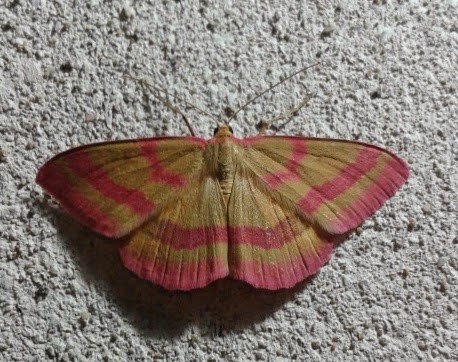I wasn't totally sure what I was expecting from Italy, particularly in regards to the wildlife. I suppose I was not expecting much to be honest, particularly as it's rarely mentioned as a destination for a wildlife holiday. On top of that this was a family holiday, and I was doubtful that I was going to get much opportunity to get out to the best wildlife sites.
We (myself, my brother, mother and step-father) touched down in Rome late-morning, and immediately I was on the lookout for birds from the car, as we made the 2 hour journey south to the town of Formia.
Zitting Cisticola could be heard singing from any small patch of grass by the roadside, and plenty of Hooded Crow and a Black Kite was spotted. Lots of Sparrows were heard and glimpsed, which of course were going to be Italian Sparrow, so the first lifer (depending on which authority you listen to of course!).
We stopped briefly near our rented villa by a flower-rich verge. Straight away, quality was found with a Spotted Clover day-flying moth, and of course the Carpenter Bee Xylocops violacea. Despite their abundance throughout the week, this was the best shot I managed!
As we pulled up to the house, I spotted something bold flitting about an Oleander bush. As soon as I could, I headed out there to take a look. It was soon found, and it was the stunning moth Nine-spotted. There are a couple of similar species, but I think the wide yellow band on the abdomen suggests it to be the commoner, Amata phegea.
I went on to see plenty more throughout the week, particularly in our garden. Talking of it, this was the view from our garden, across to the town of Gaeta.
Besides the Nine-spotted, there was plenty of stuff to be found here. It was full of Olive trees and various flowers, including these commanding Cacti.
Even more dynamically, there were plenty of butterflies flitting about, including the Cleopatra. Although at rest they closely resemble Brimstone, in flight they are unmistakable with bright red patches in the centre of the upperwing.
Along with Wall Brown, they proved to be commonest butterflies throughout the week.
There were a few birds around too, with a Sardinian Warbler singing in next-doors overgrown garden. Also a few Serin, and the ubiquitous Swift, which is probably the commonest bird here. I was desperately scanning the flocks in the hope of Pallid, which are in this region. Instead I found an Alpine Swift cruising overhead, dwarfing the commons.
A Peregrine was a fitting end to the day, steeling in and scattering the vast Swift and hirundine flock.
In the local supermarket, some drinks companies know exactly how to win my favour.
1st June
Last night, I left the outside lights on in the hoping of attracting one or two moths.
It worked, with a decent selection sitting on the wall.
One or two Geranium Wave Idaea eugeniata,
plenty of the Bee Moth-like Lamoria anella,
a few Lustrous Least Carpet Idaea filicata,
a single Least Black Arches relative, Nola chlamitulalis,
an unidentified Bee Moth-like individual, possibly a female Lamoria anella,
and lots of Rush Veneer.
Incidentally, the number of migrant moths (from a UK perspective) like the latter, was very great. How many of these were locally-bred, and how many had come from Africa, I'm not sure. Some more of those later.
Other than that start, there was little wildlife watching for the rest of the morning as we had a walk round the town. The conditions were already scorching hot.
I did find this Weasel's-snout, a rare plant in the UK.
As well as this familiar Lulworth Skipper.
In the afternoon, we went somewhere right up my street, the country park of Parco di Gianola.
The woodland there was impressive.
And carpeting it was plenty of Ivy Broomrape.
There were a few more interesting butterflies at this site, such as familiar Swallowtail, and less familiar Mallow Skipper, and Ilex Hairstreak.
I also found this stunning large caterpillar feeding on Broom, which turned out to be the larva of the rather dull noctuid, Apopestes spectrum.
There was a good view from the end of the head.
The grassland here was alive with interesting insects, such as this bold Crambid moth Angustalius malacellus.
And this pretty Flower Scarab Oxythyrea funesta.
Plus, there were lots of Burnet Moths of at least two species present. The Transparent Burnet (of the nominate subspecies, not as 'transparent' as the British subspecies) was far the commoner.
One of the most obvious creatures here, and indeed in much of the rocky and even urban areas around the place, was the Wall Lizard. The sound of them scuttling for cover from the edge of paths was an almost constant accompaniment to our walks.
There were a number of Roman ruins at this site, though the amount of mosaic remaining was rather pitiful.
We found ourselves in a tiny Roman harbour, and this turned out to be a good place for rock pooling. There were lots of Sea Anemone, which looked their most stunning out of water.
The route back through the woodland took us past a colony of Alabonia geoffrella. A species I've noted in the UK and France in the past.
Before we made it home, we went up the road to a holy shrine, which happened to be in a cave. The place was full of Bloxworth Snout.
In the evening I again put on the outside lights, and held a vigil by them for a while.
To my surprise, I spotted a number of Firefly flitting about the place, flashing their bioluminescent final segment to their body. I had no idea we had them in Europe. Turns out they are closely related to our Glow-worm.
A moth did eventually show up, and it was worth waiting for. The stunning Narrow Rose-banded Wave Rhodostrophia calabra.
A promising start to the trip!
































No comments:
Post a Comment